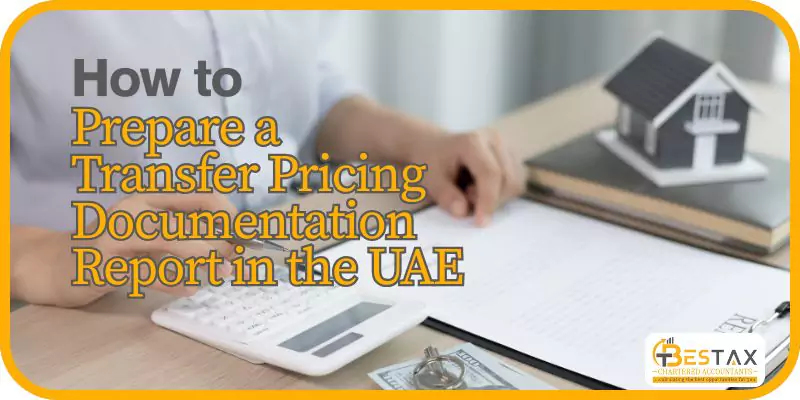If your business in the UAE deals with other parts of the same group, whether in the UAE or abroad, you must follow transfer pricing rules.
These rules make sure that prices for goods, services, or money exchanged between related companies are fair. This means they must follow the arm’s length principle, as if the companies were not connected.
The UAE has now made transfer pricing documentation a legal requirement under Article 55 of the UAE Corporate Tax Law. This includes filing a TP disclosure form, and in some cases, preparing a Master File, Local File, and a Country-by-Country Report (CbCR).
These documents help the Federal Tax Authority (FTA) check if your pricing is correct and fair.
Whether you are a large multinational or a growing UAE business, following the right steps for UAE transfer pricing documentation will help you stay compliant and avoid penalties.
What is Transfer Pricing?
Transfer Pricing means the prices charged for goods, services, or funds transferred between parts of the same company. It can also apply to intangibles, such as licenses or patents.
These internal prices must follow the arm’s length principle, just like if third parties were involved. This helps ensure profits are taxed fairly in each country. If internal prices are too high or too low, countries can adjust them and impose tax penalties.
Within the UAE, transfer pricing rules apply to any related party transactions, UAE tax, including cross-border deals between controlled parties. Transfer Pricing rules are based on OECD guidelines and require solid UAE arm’s length documentation.
Why Transfer Pricing Rules are Mandatory
Since June 1, 2023, the UAE has introduced a new Corporate Tax Law and formal transfer pricing documentation UAE rules. These rules ensure transactions within a corporate group are priced like market transactions. The goals are to:
- Ensure correct tax collection.
- Prevent profit shifting across borders.
- Support transparency and international tax standards.
Key UAE Rules & Terms
Here are the most important things to know:
- Article 55 of the UAE Corporate Tax Law requires all contemporaneous TP documentation in the UAE.
- Ministerial Decision No. 97 of 2023 sets materiality thresholds for group revenue of AED 200 million, or AED 3.15 billion globally, for CbCR UAE.
- A simple TP Disclosure Form is needed even if you do not meet thresholds, but do have related party transactions, UAE tax above the set amounts.
- UAE TP rules follow the OECD’s Master File / Local File requirements and require CbC Reporting under Cabinet Resolution No. 44 of 2020, following OECD BEPS Action 13.
When Do You Need Documentation?
You must prepare TP documentation in these cases:
- You have controlled transactions with Related Parties or Connected Persons UAE
- If your revenue is ≥ AED 200 million, or you are part of an MNE with global revenue ≥ AED 3.15 billion, you then need Master File, Local File, and CbCR UAE
Required Transfer Pricing Documentation

You must prepare:
- TP Disclosure Form
- Master File
- Local File
- Country‑by‑Country Report (CbCR)
1. TP Disclosure Form
- Filed with your UAE corporate tax return within 9 months of the year-end.
- Must list all controlled transactions above AED 4 million per category or AED 40 million total.
- Also report payments above AED 500,000 to connected persons.
- Demonstrates that transactions meet arm’s length terms.
2. Contemporaneous TP Documentation
- Create it at or before filing; hence, it is “contemporaneous documentation.”
- Includes a functional analysis (who does what, risk, assets), benchmarking study UAE, adjusted profit methods, pricing methodology, agreements, and supporting data.
3. Master File
Required when:
- Group revenue ≥ AED 200 million, or part of a larger group ≥ AED 3.15 billion.
- Contains group-wide information: structure, business model, intangibles, financial flows, TP policies.
4. Local File
Also needed under the same thresholds. It includes:
- Detailed analysis specific to the UAE entity.
- Lists controlled transactions and how they are priced.
- Includes benchmarking analysis, comparability adjustments, and method choice.
5. Country‑by‑Country Report (CbCR)
For groups with global revenue ≥ AED 3.15 billion:
- Notify the FTA by year-end.
- Submit CbC report within 12 months.
- Includes per-country data on revenue, profits, taxes, employees, and assets.
How to Prepare Transfer Pricing Documentation
Follow these clear steps:
- Identify Related & Connected Persons UAE (per Articles 35 & 36).
- List all controlled transactions and total values.
- Do functional analysis: define roles, assets, and risks.
- Choose TP method: CUP, RPM, TNMM, Profit Split, or adjusted profit methods.
- Run a benchmarking study UAE to find comparable transactions.
- Gather contemporaneous support: agreements, emails, data, and financials.
- Complete the TP Disclosure Form
- If required, prepare Master and Local Files following Master File / Local File requirements.
- If applicable, prepare CbCR UAE and file notification.
- Submit TP forms with your tax return within 9 months of the year-end.
- Keep all documentation ready as the FTA may request under Article 55.
Important Revenue Thresholds for UAE TP Compliance
- AED 4 million per category or AED 40 million total – triggers TP Disclosure Form.
- AED 500,000 payments to connected persons must be noted.
- AED 200 million group revenue – triggers Master & Local Files.
- AED 3.15 billion global group revenue triggers CbCR.
Stay Compliant: UAE Transfer Pricing Best Practices
Preparing accurate and complete transfer pricing documentation in the UAE is now more important than ever. Whether your business engages in related party transactions, connected persons UAE dealings, or is part of a multinational group, you must follow the rules set by Article 55 UAE Corporate Tax Law and Ministerial Decision No. 97 of 2023.
By preparing your TP disclosure form, Master File and Local File, and, if required, a Country-by-Country Report UAE, you show compliance with the arm’s length principle and reduce the risk of tax adjustments or penalties.
Contact Bestax for expert help in preparing, reviewing, and submitting your UAE transfer pricing documentation.
Our team ensures your business complies with all FTA regulations and stays audit-ready.
Quick FAQs
When must I prepare a Transfer Pricing disclosure form and TP files?
You must include a TP disclosure form, Master File, Local File, and supporting documents showing that your transactions follow the arm’s length principle. The report should cover related party details, pricing methods, functional analysis, and benchmarking.
When must I prepare a Transfer Pricing disclosure form and TP files?
You must file the disclosure form with your corporate tax return if your related party transactions cross set thresholds. TP files are required if your UAE revenue is AED 200 million or if your group revenue is AED 3.15 billion.
What are the thresholds for Master File, Local File & CbCR under UAE law?
The Master File and Local File are needed if your UAE revenue is at least AED 200 million or if you’re part of a group with global revenue over AED 3.15 billion. CbCR is only for multinational groups meeting the AED 3.15 billion threshold.
How do I conduct a benchmarking study for UAE transfer pricing?
A benchmarking study compares your company’s prices with similar independent companies using public databases. It helps show your prices are fair and match the arm’s length principle.
Can TP documentation be provided upon FTA request only?
No, TP documentation must be prepared at the time of filing and kept ready—it must be contemporaneous. The FTA can ask for it during audits, but it must already exist.
What happens if I fail to prepare contemporaneous TP documentation?
The FTA may adjust your taxable income and impose penalties if documentation is missing or late. It can also deny tax deductions for non-arm’s length payments.
Does a Free Zone company need TP documentation?
Yes, Free Zone companies must follow transfer pricing rules if they have related party transactions or are part of a qualifying group. The same thresholds and rules apply as to mainland entities.
How long should UAE TP documentation be retained?
You must keep all transfer pricing documents for at least seven years from the end of the relevant tax period. These must be made available to the FTA when requested.
How can Bestax help with TP documentation and reporting?
Bestax can help you prepare your TP disclosure form, conduct benchmarking studies, and create Master and Local Files that meet UAE law. Visit Bestax Transfer Pricing Services to get expert support.
Disclaimer: The information provided in this blog is for general informational purposes only. For professional assistance and advice, please contact experts.





